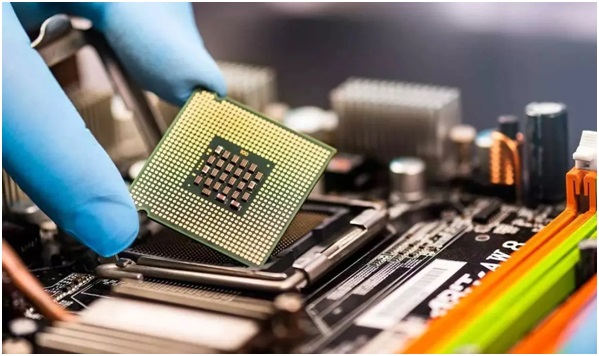Production Linked Incentive (PLI) Scheme for IT Hardware (Business Standard)

- 01 Sep 2023
Why in the News?
As many as 38 companies, including big names like Foxconn Group, HP, Dell and Lenovo, have applied for incentives under the mega Production Linked Incentive (PLI) IT hardware scheme for manufacturing laptops, PCs and servers.
Context:
- In addition to Asus, Dell, HP, and Foxconn, several other companies, including Lenovo, Acer, and Flex, have submitted applications for the scheme. Notably, Flex is reportedly involved in manufacturing Reliance's JioBook laptop.
- HP Enterprises (HPE) has also sought approval for server manufacturing operations within India.
- Although the expected incremental production over the scheme's six-year duration is projected to reach Rs 3.35 lakh crore, the anticipated additional investment during this period is relatively modest, at just Rs 4,000 crore.
- The government anticipates that the manufacturing activities enabled by the scheme will create approximately 75,000 direct jobs, with the potential to generate up to 2 lakh indirect jobs when considering the broader economic impact.
What is the PLI Scheme?
- The PLI scheme was created to boost domestic manufacturing, reduce reliance on imports, and create more jobs.
- The government has allocated Rs 1.97 lakh crore for various sectors under the PLI schemes, with an additional Rs 19,500 crore designated for PLI in solar PV modules in the 2022-23 Budget.
- Initiated in March 2020, the scheme initially focused on three industries:
- Mobile and allied Component Manufacturing
- Electrical Component Manufacturing
- Medical Devices
- Incentives Under the Scheme:
- The incentives, based on increased sales, vary from 1% for electronics and technology products to 20% for critical key starting drugs and certain drug intermediaries.
- In some sectors like advanced chemistry cell batteries, textile products, and the drone industry, incentives are calculated based on sales, performance, and local value addition over a five-year period.
- Sectors Covered by the PLI Scheme:
- The government has introduced PLI schemes for 14 sectors, including automobiles and auto components, electronics and IT hardware, telecom, pharmaceuticals, solar modules, metals and mining, textiles and apparel, white goods, drones, and advanced chemistry cell batteries.
- Objectives:
- The government introduced this scheme to reduce India's dependence on foreign countries, particularly China.
- It aims to support labor-intensive sectors and increase employment in India while reducing import bills and promoting domestic production.
- The PLI Yojana also encourages foreign companies to establish operations in India and domestic enterprises to expand their production facilities.
What is the PLI scheme for IT Hardware?
- The PLI scheme for IT Hardware was initially announced in February 2021, with an initial allocation of approximately Rs 7,300 crore over a four-year period.
- Incentive Structure:
- Under this scheme, domestic companies that invest Rs 20 crore and achieve sales of Rs 50 crore in the first year, Rs 100 crore in the second year, Rs 200 crore in the third year, and Rs 300 crore in the final year can receive incentives ranging from 1% to 4% on incremental sales compared to the base year of 2019-20.
- Revised Version:
- The initial version of the scheme had limited success, with only two companies, Dell and Bhagwati, meeting the first-year targets.
- Consequently, the industry called for a revamped scheme with a larger budget.
- In response, the Union Cabinet approved a revised PLI scheme for IT hardware in May 2023, allocating Rs 17,000 crore, more than doubling the budget.
- Potential Impact:
- PLI 2.0 has the potential to attract major global IT hardware manufacturers to establish their production operations in India, bolstering the local production of laptops, servers, personal computers, and more.
- Over a six-year period, the average incentive is expected to be around 5%, compared to the previous 2% over four years.
- Achieving Digital Economy Goals:
- With the IT hardware industry aiming for a production value of $24 billion by 2025-26 (with exports estimated at $12-17 billion), this scheme plays a crucial role in realizing the goal of a $1 trillion digital economy, including $300 billion from electronics manufacturing by 2025-26.
How Will the PLI Scheme Drive Local Production in India?
- Despite identifying electronics manufacturing as a pivotal sector for future economic growth, India has witnessed a surge in the import of electronic goods in recent years.
- Import Scenario:
- For instance, the import of electronic goods surged to $6.96 billion during April-June this year, up from $4.73 billion in the same period last year, constituting 4-7% of overall imports.
- The category with the highest import share includes personal computers, including laptops and palmtops.
- China Dominance:
- China commands a significant portion, approximately 70-80%, of India's imports in the personal computer and laptop category.
- Incentives for Component Manufacturers:
- Companies engaged in local manufacturing of specific components like memory modules and display panels will receive supplementary incentives under the revised scheme.
- Performance-Driven Approach:
- The PLI scheme is designed to encourage companies to meet production targets.
- If companies fall short of these thresholds, they may face deductions of up to 10% from their subsidies.
- Synergy with Semiconductor Scheme:
- The PLI scheme will complement the government's semiconductor scheme, with domestically produced chips finding application in laptop manufacturing, further bolstering the local industry.
Mains Question:
- Discuss the impact of the PLI Scheme for IT Hardware on the Indian electronics manufacturing sector. Evaluate its effectiveness in reducing imports and critically assess its potential to stimulate job growth in the country. (15M)
